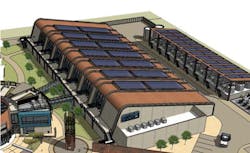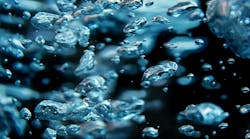CALIFORNIA, NOVEMBER 16, 2016 -- Biwater have been awarded a contract to design, supply and supervise the installation and commissioning of both ultrafiltration (UF) and reverse osmosis (RO) systems for the Groundwater Reliability Improvement Program (GRIP) advanced water treatment facility being constructed in Pico Rivera, Southern California.
The new 14.8 million US gallon per day (56 million liter per day) plant will support the Water Replenishment District (WRD) of Southern California in its aim to be 100 percent independent from imported water. Site work is underway following the recent ground breaking ceremony to meet a completion date of July 2018.
"Biwater is on track to supply state-of-the-art UF and RO systems by late 2017 for the new GRIP advanced water treatment plant. The membrane systems are two of the three key process technologies essential to the indirect potable reuse solution. Biwater's membrane technologies will help replenish groundwater supplies to ensure local aquifers are sustainable and continue to be a vital and growing contributor to the region's water demands," said Jorg Menningmann, President of Biwater's Membrane Treatment and Desalination Sector (Biwater Inc.).
Technical overview
The source water for the new GRIP facility is tertiary effluent from two wastewater treatment plants. The 10 train UF process will remove particulates and organisms prior to the RO membranes, thereby contributing to stable RO operation and performance. To enhance overall system recovery rates, backwash waste from the primary UF system will be processed by a subsequent secondary recovery UF system. Overall recovery for the UF system will be 99.7 percent.
Thereafter, the UF filtrate will be treated by four primary RO trains (2 stage) followed by four concentrator RO trains (1 stage) running at a product recovery rate of 92.7 percent. The RO membranes will remove/reduce ionised salts and dissolved organics such as metals, nitrates and total organic content (TOC).
The combined RO product will then be sent through a chemical oxidation/ultraviolet (UV) reactor advanced oxidation process, which will breakdown low molecular weight compounds in the category of Contaminants of Emerging Concern (CECs).
The system operations will be optimised prior to start-up with data gathered from pilot plant operations that will run concurrently with the initial design phases of the project. This data will be instrumental for tuning in chemical feed rates and membrane cleaning frequency and techniques. As the raw water source is unique and variable with two different sources, the pilot plant data will be invaluable and allow us to begin initial operations with optimum conditions. Biwater's ultimate goal for the pilot plant is to fine tune the operations to reduce energy and chemical consumption and extend useful membrane life.
Parties involved
Main contractor: J. F. Shea Construction
Design engineering: Tetra Tech
UF/RO Designer and Systems Supplier: Biwater
Interim operator following construction: Perc Water
About Biwater
Biwater provides large-scale water and wastewater solutions for clients across the world. Since its inception in 1968, Biwater has gained recognition for its innovative approaches aimed at overcoming world's most pressing water-related challenges. Throughout its history, the company has grown to meet the demands of many water-stressed countries and their burgeoning populations. It has a successful record of accomplishment, having completed over 25,000 projects in over 90 countries – financing, consulting, process engineering, designing, constructing, operating, maintaining and owning water facilities – in both rural and urban environments.
Membrane Treatment and Desalination Sector
Biwater's Membrane Treatment and Desalination Sector (Biwater Inc.) is a premier membrane system designer and supplier producing high purity drinking, process and reuse water for both municipal and industrial clients. The Group currently has more than 450 MGD (US) of installed membrane treatment capacity globally utilising MF, UF, MBR, NF and RO technologies.




